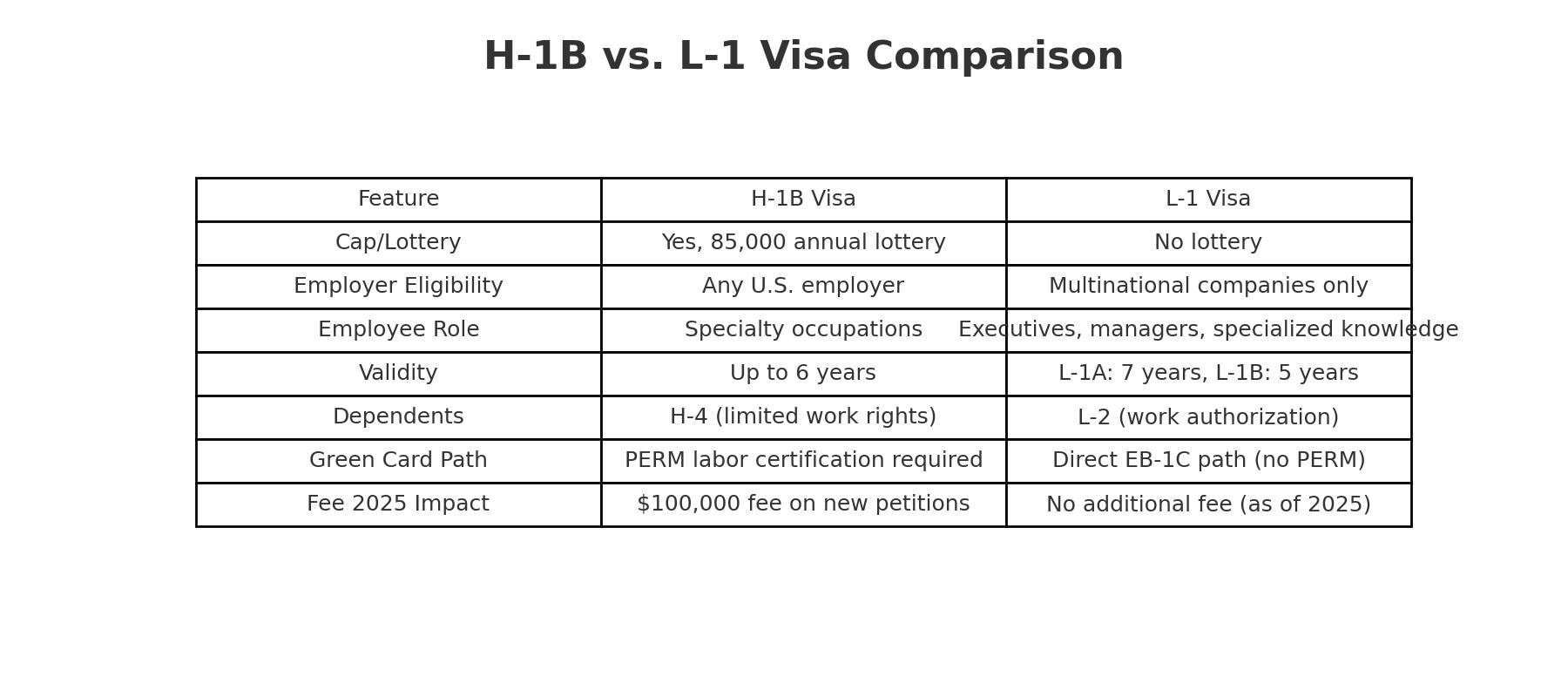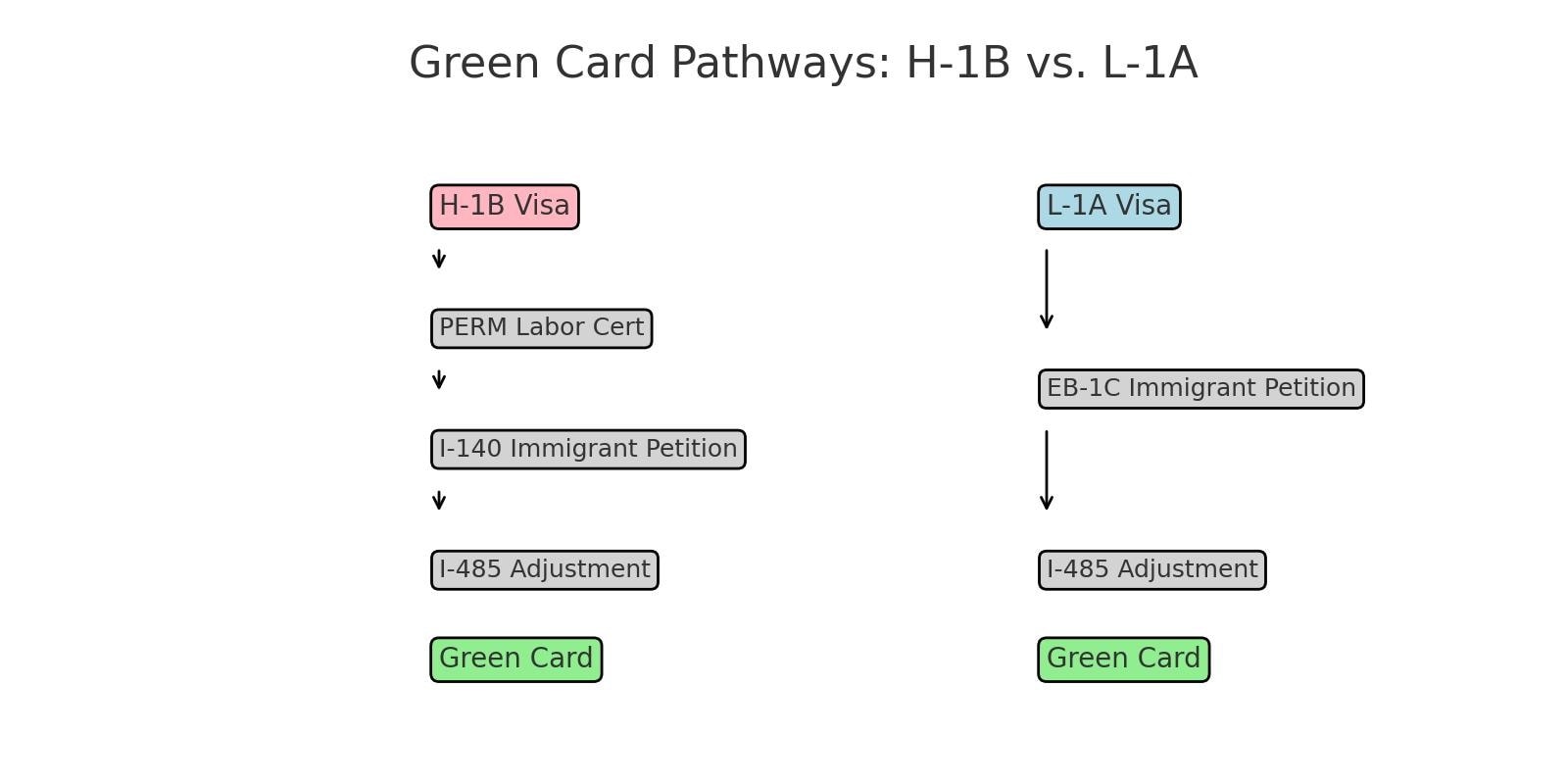Introduction
With the Trump administration’s $100,000 H-1B filing fee reshaping the U.S. immigration landscape, the L-1 visa is emerging as the top H-1B alternative. While the H-1B remains a cornerstone for skilled foreign workers, the cost, restrictions, and uncertainty are pushing multinational employers to re-examine the L-1A and L-1B intra-company transfer visas. In light of the new fee, companies are also considering cheaper alternatives such as the L-1 and O-1 visas to manage costs more effectively.
This comprehensive guide explores whether the L-1 visa could replace the H-1B, or at least serve as the best backup. Understanding different visa types is crucial for navigating this new landscape and ensuring compliance with evolving regulations. We’ll compare eligibility requirements, benefits, and risks, explain strategies for employers, and project how Trump’s immigration policy—a major shift driven by the $100,000 H-1B fee—will affect global talent mobility.

H-1B in Crisis: Trump’s $100,000 Fee Explained
The Proclamation in Detail
On September 19, 2025, President Trump signed an [executive order imposing a $100,000 filing fee](USCIS announcement.https://www.whitehouse.gov/presidential-actions/2025/09/restriction-on-entry-of-certain-nonimmigrant-workers/)** on all new H-1B petitions** filed after September 21, 2025. This unprecedented fee is framed as a “protective measure” to deter abuse and prioritize American workers. The Secretary of Homeland Security is responsible for implementing this rule and determining exemptions. In particular, homeland security determines whether certain cases qualify for exemptions or special consideration based on national interest or security concerns.
Key points:
- Applies only to new H-1B petitions, not extensions.
- It is a one-time fee, not annual.
- Current H-1B holders are exempt.
- Petitions filed before September 21, 2025, are unaffected.
The Economic and Practical Impact
- Small and mid-sized businesses: For a 20-person IT firm, a single H-1B hire could equal months of payroll.
- Universities and nonprofits: Often dependent on H-1Bs for research positions, but with less financial flexibility.
- Large corporations: May still file, but could limit the volume of petitions. Large firms may use blanket petitions to streamline processing and support their global workforce.
The new fee could impact the careers and welfare of both U.S. and foreign workers, affecting job opportunities, professional development, and economic stability.
Why Employers Are Exploring Alternatives
- Cost sensitivity: Few employers want to risk $100,000 on a lottery-based system, leading to companies opting for alternative visa categories like L-1 and O-1 due to the increased costs of H-1B.
- Legal risks: High RFE (Request for Evidence) and denial rates mean the money could be lost.
- Uncertainty: The H-1B is no longer predictable.

The Rise of the L-1 Visa
What Is the L-1 Visa?
The L-1 visa allows multinational companies to transfer employees who have been employed abroad by the same organization from an overseas branch, parent, subsidiary, or affiliate to a U.S. office. Only the company can file a petition for the L-1 visa on behalf of the employee, and the process is essential for facilitating intra-company transfers.
- L-1A Visa: Executives and managers (valid for up to 7 years).
- L-1B Visa: Specialized knowledge employees (valid for up to 5 years).
Why It’s Attractive in 2025
The L-1 visa is ideally suited for multinational companies seeking to transfer key personnel.
- No cap or lottery. The L-1 is not restricted by a cap or lottery system.
- Dual intent recognized (green card possible).
- Flexibility: Employees can move between global offices.
- Dependents: L-2 spouses can work.
- L-1A: Allows for extended stays for executives and managers.
- L-1B: Allows for extended stays for employees with specialized knowledge.
USCIS overview of L-1A and L-1B visa requirements.
L-1 vs. H-1B: Key Differences

The L-1 visa bypasses the H-1B lottery and fee while providing a faster path to permanent residency for executives and managers and specialized knowledge workers. Unlike the H-1B, which is specifically for specialty occupations that require at least a bachelor’s degree in a relevant field, the L-1 does not have a bachelor’s degree requirement. Additionally, H-1B employers must pay the prevailing wage, which is typically above the minimum wage, to comply with Department of Labor standards, whereas the L-1 visa has no minimum wage or prevailing wage requirement.
Other visa types, such as O-1 and TN, may also be considered as alternatives depending on your qualifications and circumstances.

Advantages of the L-1 Visa
- No Lottery: Employers avoid the gamble of the H-1B lottery, gaining greater transparency and peace of mind throughout the L-1 process.
- Dual Intent: Unlike many nonimmigrant visas, L-1 holders can apply for a green card.
- Fast-Track to Green Card: L-1A executives/managers often transition directly into EB-1C without labor certification.
- Work Rights for Spouses: L-2 spouses are eligible for employment authorization.
- International Mobility: The visa facilitates rotations and cross-border leadership development.
Challenges and Risks of the L-1
- High Denial Rates: Particularly for L-1B “specialized knowledge” petitions.
- Strict Documentation Requirements: Companies must prove corporate relationships and job duties.
- Fraud Concerns: USCIS closely investigates to prevent abuse. Exemptions may be granted in cases where there is no threat to U.S. workers’ wages or welfare.
- Barriers for Small Companies: Startups without foreign operations can’t qualify.
The L-1 visa can be powerful, but only multinational companies with strong documentation will succeed.
Could the L-1 Replace the H-1B?
Feasibility Analysis
The L-1 cannot replace the H-1B entirely. It is limited to employees of multinational companies and cannot serve independent employers. However, for eligible businesses, the L-1 may become the default alternative.
Industries Most Likely to Benefit
- Technology (global product teams, R&D).
- Consulting & Finance (international project managers).
- Manufacturing (supply chain and operations managers).
Limitations
- Small U.S.-only companies are excluded.
- Specialized knowledge remains vague and contested.
Practical Guidance for Employers
When to Choose L-1 Over H-1B
- If the employee already works at a foreign branch.
- If the position is executive, managerial, or specialized knowledge.
- If the company anticipates permanent residency filings.

Compliance Tips
- Maintain detailed organizational charts.
- Document the employee’s foreign and U.S. job duties.
- Prepare for USCIS site visits.
Potential Case Study: Tech Firm Transfer
India is a leading source country for L-1 visa applicants and multinational employee transfers. A mid-sized Indian IT firm with U.S. operations shifted 60% of its new U.S. hires to L-1B visas in 2025, avoiding the $100,000 H-1B fee while keeping teams agile.
The Future Landscape of U.S. Work Visas
Under Trump’s Immigration Policy
- Expect more employer-driven alternatives like the L-1.
- Continued litigation challenging the H-1B fee.
- Possible policy shifts making L-1 documentation even stricter.
Other Alternatives Beyond L-1
- O-1 Visa: For individuals with extraordinary abilities, intended for those who have demonstrated exceptional talent or achievements in their field.
- TN Visa: Available to Canadians and Mexicans under USMCA.
- E-2 Investor Visa: For entrepreneurs from treaty countries.
- EB-5 Visa: For investors contributing $800,000+ into U.S. projects.
- Gold Card: Another alternative for permanent residence, but it does not guarantee a faster or simpler green card process and does not eliminate immigration risks.

FAQs: Why the L-1A and L-1B Visas May Be the New H-1B Visa
What is the main reason the L-1 visa is seen as the new H-1B visa after Trump’s $100,000 fee?
The L-1 visa is gaining attention because it avoids the $100,000 H-1B filing fee, is not subject to an annual lottery, and allows multinational companies to transfer executives, managers, and employees with specialized knowledge.
Does the $100,000 H-1B filing fee apply to the L-1 visa?
No. The fee applies only to new H-1B petitions filed after September 21, 2025. L-1 petitions are not subject to this fee.
Why do employers consider the L-1 visa a better H-1B alternative?
Employers view the L-1 as more predictable since it has no lottery, provides dual intent, allows spousal work authorization, and offers a faster green card path for executives and managers.
Who qualifies for the L-1A visa?
The L-1A visa is for executives and managers transferring from a foreign office to a U.S. branch, subsidiary, or affiliate. It allows stays of up to 7 years.
Who qualifies for the L-1B visa?
The L-1B visa is for employees with “specialized knowledge” of a company’s products, services, processes, or technologies. It allows stays of up to 5 years.
How is the L-1 visa different from the H-1B visa?
Unlike the H-1B, the L-1 is not capped by a lottery, is limited to multinational employers, and can lead directly to a green card through the EB-1C category for executives and managers.
Why is the L-1A visa attractive for executives and managers?
The L-1A provides a fast track to permanent residency through EB-1C without requiring a labor certification, making it more efficient than the H-1B route.
Is the L-1 visa subject to a prevailing wage requirement like the H-1B?
No. Employers are not required to meet Department of Labor prevailing wage rules for L-1 workers, giving companies more flexibility in compensation.
How long must an employee work abroad before becoming eligible for the L-1 visa?
The employee must have worked for the foreign office for at least one continuous year within the three years before applying for an L-1 transfer.
Can dependents of L-1 visa holders work in the United States?
Yes. L-2 spouses of L-1 visa holders are eligible for work authorization, a major advantage compared to many H-4 dependents of H-1B workers.
What are the risks of using the L-1 visa instead of the H-1B visa?
The biggest risks include strict USCIS scrutiny, high denial rates for L-1B specialized knowledge petitions, and compliance burdens for multinational companies.
Is the L-1 visa a good option for small companies or startups?
Only if the company has international operations. Startups without foreign offices cannot use the L-1 visa.
Can an L-1 visa holder eventually obtain a green card?
Yes. L-1A executives and managers often apply for EB-1C immigrant visas, while L-1B specialized knowledge workers may need to transition to other categories.
Why might the L-1B visa be more difficult to obtain than the L-1A visa?
The L-1B requires proof of “specialized knowledge,” a vague and highly scrutinized standard that often results in Requests for Evidence (RFEs) and denials.
Is premium processing available for L-1 visas?
Yes. Employers can request 15-day processing for an additional fee, offering faster turnaround compared to standard review times.
Can new U.S. offices use the L-1 visa to bring employees to the U.S.?
Yes, but the initial L-1 approval is limited to one year, and extensions require evidence that the U.S. office is viable and operational.
Does the L-1 visa offer more global flexibility than the H-1B visa?
Yes. The L-1 visa is designed for intra-company mobility, making it easier for multinational corporations to rotate executives and specialists across borders.
What industries benefit most from shifting from H-1B to L-1 visas?
Industries with multinational structures—such as technology, consulting, finance, and manufacturing—gain the most because they often have overseas offices that qualify for L-1 transfers.
Could the government expand Trump’s $100,000 fee to L-1 visas?
It is possible future policy changes could impose new costs, but as of now, the L-1 visa remains free of this fee, making it more attractive.
Bottom Line: Is the L-1 the new H-1B?
For multinational employers, the L-1 visa is rapidly becoming the most viable H-1B alternative, especially in light of the $100,000 H-1B filing fee. While it cannot replace the H-1B entirely, it offers a strategic path for global companies to continue hiring and transferring key talent into the United States.
Let Us Help
The $100,000 H-1B filing fee has changed the future of global hiring. Employers and talented professionals who once relied on the H-1B visa are now asking: Is the L-1A or L-1B visa the smarter path forward?
The answer isn’t simple. The L-1A and L-1B visas offer real advantages—no lottery, spousal work authorization, and, for executives and managers, a direct green card pathway through EB-1C. But they also come with challenges: strict eligibility rules, complex documentation, and aggressive USCIS scrutiny. Choosing the right strategy could mean the difference between keeping your team together in the U.S. or losing vital opportunities.
This is where Attorney Richard T. Herman can help. With over 30 years of experience, Richard has built a national reputation as an immigration law expert and advocate for immigrant talent. As co-author of Immigrant, Inc., he has long championed the role of global professionals in driving innovation and growth in America. His insight and passion have guided multinational companies, entrepreneurs, and skilled workers through some of the toughest immigration shifts in U.S. history.
If you have questions about whether the L-1A or L-1B visa is the right alternative to the H-1B in light of Trump’s unprecedented $100,000 fee, you deserve advice from someone who not only knows the law but also understands the stakes.
Take control of your future today. Schedule a confidential consultation with Attorney Richard T. Herman and explore how the L-1 visa may be the best path for you, your family, or your business.
Comprehensive Resource List
Official H-1B $100,000 Filing Fee – Announcements & Overviews
https://www.uscis.gov/newsroom/alerts/h-1b-faq — USCIS H-1B FAQ (new $100,000 fee, scope, timing)
https://www.whitehouse.gov/fact-sheets/2025/09/fact-sheet-president-donald-j-trump-suspends-the-entry-of-certain-alien-nonimmigrant-workers/ — White House Fact Sheet (policy rationale, fee language)
https://www.whitehouse.gov/presidential-actions/2025/09/restriction-on-entry-of-certain-nonimmigrant-workers/ — White House Presidential Action (EO text)
https://www.uscis.gov/sites/default/files/document/memos/H1B_Proc_Memo_FINAL.pdf — USCIS Implementation Memo (procedural guidance)
https://www.uscis.gov/sites/default/files/document/reports/ola_signed_h1b_characteristics_congressional_report_FY24.pdf — USCIS H-1B Characteristics Report (FY24 data)
L-1A / L-1B Eligibility & Policy (Government)
https://www.uscis.gov/working-in-the-united-states/temporary-workers/l-1a-intracompany-transferee-executive-or-manager — USCIS L-1A (Executives/Managers)
https://www.uscis.gov/working-in-the-united-states/temporary-workers/l-1b-intracompany-transferee-specialized-knowledge — USCIS L-1B (Specialized Knowledge)
https://www.uscis.gov/policy-manual/volume-2-part-l — USCIS Policy Manual, Vol. 2, Part L (Intracompany Transferees)
https://www.uscis.gov/policy-manual/volume-2-part-l-chapter-1 — Policy Manual: Chapter 1 (Purpose & Background)
https://www.uscis.gov/policy-manual/volume-2-part-l-chapter-4 — Policy Manual: Chapter 4 (Specialized Knowledge – L-1B)
https://www.uscis.gov/policy-manual/volume-2-part-l-chapter-5 — Policy Manual: Chapter 5 (Ownership & Control)
https://www.uscis.gov/policy-manual/volume-2-part-l-chapter-6 — Policy Manual: Chapter 6 (Key Concepts; one-year abroad, qualifying relationship)
https://fam.state.gov/FAM/09FAM/09FAM040212.html — U.S. Department of State: 9 FAM 402.12 (L Intracompany Transferees)
Adjustment of Status & Green-Card Pathways (Context for L-1A → EB-1C)
https://www.uscis.gov/green-card/green-card-processes-and-procedures/fiscal-year-2023-employment-based-adjustment-of-status-faqs — USCIS Employment-Based AOS FAQs (visa availability/timing context)
DOL: LCA / H-1B Background (for comparison and policy context)
https://www.dol.gov/agencies/eta/foreign-labor — DOL Office of Foreign Labor Certification (program hub)
https://www.dol.gov/agencies/eta/foreign-labor/programs/h-1b — DOL H-1B Program (OFLC)
https://flag.dol.gov/programs/LCA — DOL FLAG: LCA (H-1B/H-1B1/E-3) portal
https://www.dol.gov/agencies/whd/immigration/h1b — DOL WHD: H-1B (wage/working conditions)
https://www.dol.gov/sites/dolgov/files/ETA/oflc/pdfs/OFLC_H-1B-H-1B1-E-3_FAQs_Round-4_08.24.23.pdf — DOL OFLC H-1B/H-1B1/E-3 FAQs (short-term placement, etc.)
Useful USCIS L-1 Practice Notes (Supplemental)
https://www.uscis.gov/working-in-the-united-states/temporary-workers/l-1b-intracompany-transferee-specialized-knowledge/filing-multiple-l-1-intracompany-transferee-petitions-related-to-the-same-project — USCIS: Filing Multiple L-1s for the Same Project
https://www.uscis.gov/newsroom/alerts/uscis-updates-receipts-process-for-form-i-129s — USCIS Alert: Blanket L (Form I-129S) Receipt Process
Professional Associations (for monitoring updates)
https://www.aila.org/ — American Immigration Lawyers Association (AILA)
https://www.nafsa.org/ — NAFSA: Association of International Educators







